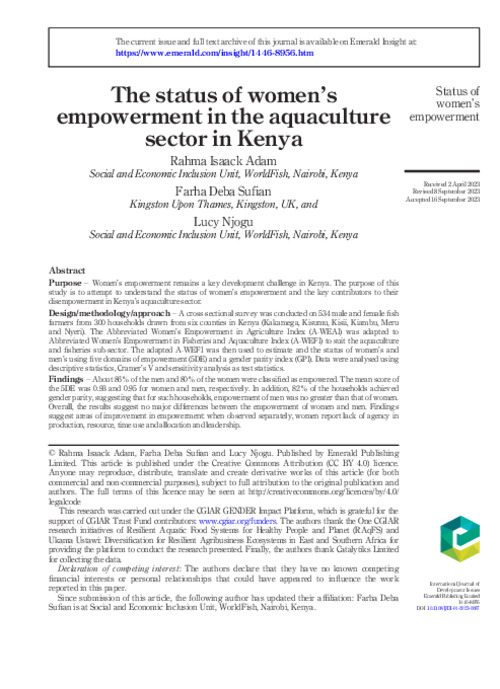Please use this identifier to cite or link to this item:
https://hdl.handle.net/20.500.12348/5703
The status of women’s empowerment in the aquaculture sector in Kenya
| dc.creator | Adam, R. | en_US |
| dc.creator | Subian, F.D. | en_US |
| dc.creator | Njogu, L. | en_US |
| dc.date.accessioned | 2023-12-10T21:19:28Z | |
| dc.date.available | 2023-12-10T21:19:28Z | |
| dc.date.issued | 2023 | en_US |
| dc.identifier.citation | Rahma Adam, Farha Subian, Lucy Njogu. (30/11/2023). The status of women’s empowerment in the aquaculture sector in Kenya. International Journal of Development Issues. | en_US |
| dc.identifier.issn | 1446-8956 | en_US |
| dc.identifier.uri | https://hdl.handle.net/20.500.12348/5703 | |
| dc.description.abstract | Purpose Women’s empowerment remains a key development challenge in Kenya. The purpose of this study is to attempt to understand the status of women’s empowerment and the key contributors to their disempowerment in Kenya’s aquaculture sector. Design/methodology/approach A cross-sectional survey was conducted on 534 male and female fish farmers from 300 households drawn from six counties in Kenya (Kakamega, Kisumu, Kisii, Kiambu, Meru and Nyeri). The Abbreviated Women’s Empowerment in Agriculture Index (A-WEAI) was adapted to Abbreviated Women’s Empowerment in Fisheries and Aquaculture Index (A-WEFI) to suit the aquaculture and fisheries sub-sector. The adapted A-WEFI was then used to estimate and the status of women’s and men’s using five domains of empowerment (5DE) and a gender parity index (GPI). Data were analysed using descriptive statistics, Cramer’s V and sensitivity analysis as test statistics. Findings About 86% of the men and 80% of the women were classified as empowered. The mean score of the 5DE was 0.93 and 0.95 for women and men, respectively. In addition, 82% of the households achieved gender parity, suggesting that for such households, empowerment of men was no greater than that of women. Overall, the results suggest no major differences between the empowerment of women and men. Findings suggest areas of improvement in empowerment: when observed separately, women report lack of agency in production, resource, time-use and allocation and leadership. Originality/value This paper adapts the A-WEAI to the fisheries and aquaculture context, in bid to bridge the gap in standard women’s empowerment measurement methods in this area. Also, there are limited empirical studies on the multifaceted empowerment of women in aquaculture in Kenya. The findings are meant to serve as a point of reference for policymakers, as they develop gender-responsive intervention programmes, and in implementing gender mainstreaming in Kenya. | en_US |
| dc.format | en_US | |
| dc.language | en | en_US |
| dc.publisher | Emerald | en_US |
| dc.rights | CC-BY-4.0 | en_US |
| dc.source | International Journal of Development Issues;(2023) | en_US |
| dc.subject | agency | en_US |
| dc.title | The status of women’s empowerment in the aquaculture sector in Kenya | en_US |
| dc.type | Journal Article | en_US |
| cg.contributor.funder | CGIAR Gender Platform | en_US |
| cg.contributor.funder | CGIAR Trust Fund | en_US |
| cg.coverage.country | Kenya | en_US |
| cg.coverage.region | Eastern Africa | en_US |
| cg.subject.agrovoc | aquaculture | en_US |
| cg.subject.agrovoc | kenya | en_US |
| cg.subject.agrovoc | gender equality | en_US |
| cg.subject.agrovoc | women’s empowerment | en_US |
| cg.subject.agrovoc | fish | en_US |
| cg.contributor.affiliation | WorldFish | en_US |
| cg.identifier.status | Open access | en_US |
| cg.contribution.worldfishauthor | Adam, R. | en_US |
| cg.contribution.worldfishauthor | Subian, F.D. | en_US |
| cg.contribution.worldfishauthor | Njogu, L. | en_US |
| cg.description.theme | Gender | en_US |
| dc.identifier.doi | https://dx.doi.org/10.1108/IJDI-04-2023-0087 | en_US |
| cg.subject.actionArea | Resilient Agrifood Systems | en_US |
| cg.contributor.initiative | Aquatic Foods | en_US |
| cg.contributor.initiative | Diversification in East and Southern Africa | en_US |
Files in this item
This item appears in the following Collection(s)
-
Gender [323]
